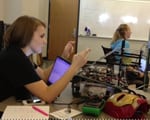
What will soon be the most powerful neutrino detector in the United States has recorded its first three-dimensional images of particles.
Using the first completed section of the NOvA neutrino detector under construction in Minnesota, scientists have begun collecting data from cosmic rays—particles produced by a constant rain of atomic nuclei falling on the Earth’s atmosphere from space.
Scientists’ goal for the completed detector is to use it to discover properties of mysterious fundamental particles called neutrinos.
Neutrinos are as abundant as cosmic rays in the atmosphere, but they have barely any mass and interact much more rarely with other matter. Many of the neutrinos around today are thought to have originated in the Big Bang when the universe began.
“These recent tests with the very first portions of our eventual 14,000-ton detector are extremely gratifying since they give us confidence that after many years of work by many people, and innumerable design meetings, our detector is actually becoming alive,” said physicist Thomas E. Coan, an associate professor of physics at Southern Methodist University. “There now seem to be no fundamental show stoppers lurking around.”
SMU hosted in January the most recent general meeting for the experiment known by the acronym NOvA.
“That was the last meeting before these tests were completed and it allowed us to settle details of the tests and make sure they would be crisp and meaningful,” Coan said. “Overall, understanding neutrinos is essential to understanding our universe at a deep level. But studying them is also considerable fun since they are so weird.”
The active section of the detector, under construction in Ash River, Minn., is about 12 feet long, 15 feet wide and 20 feet tall. The full detector will measure more than 200 feet long, 50 feet wide and 50 feet tall.
“It’s taken years of hard work and close collaboration among universities, national laboratories and private companies to get to this point,” said Pier Oddone, director of the Department of Energy’s Fermi National Accelerator Laboratory. Fermilab manages the project to construct the detector.
“The more we know about neutrinos, the more we know about the early universe and about how our world works at its most basic level,” said NOvA co-spokesperson Gary Feldman of Harvard University.
“A possible path to understanding why any matter at all is present in our universe — including the matter that comprises us — is to understand the behavior of neutrinos, which are especially mysterious subatomic particles,” said SMU’s Coan.
“Neutrinos are almost a billion times more numerous in the universe than hydrogen, the universe’s most abundant element. But with a mass more than a million times smaller than an electron’s, the electrically neutral neutrino interacts extraordinarily feebly with matter,” he said. “A common reference scale is that a neutrino needs to travel a distance of a light year through lead before it will interact with another particle. Neutrinos also have the peculiar property that they morph from one type — or “flavor” — to another as they travel.”
Later this year, Fermilab, outside of Chicago, will start sending a beam of neutrinos 500 miles through the earth to the NOvA detector near the Canadian border. When a neutrino interacts in the NOvA detector, the particles it produces leave trails of light in their wake. The detector records these streams of light, enabling physicists to identify the original neutrino and measure the amount of energy it had.
“The morphing of a muon flavor neutrino to an electron flavor neutrino is particularly interesting,” Coan said, noting that the flavor of a neutrino is determined by what electrically charged particles it produces when it eventually interacts with matter. “An electron neutrino produces electrons while a muon neutrino produces a muon, which is a kind of heavy, radioactive electron.”
The whole phenomenon of neutrino morphing — called “neutrino flavor oscillation” — is poorly understood, he said, but needs to be if neutrino interactions in the early universe can be sensibly thought to be central to explaining the subsequent absence of antimatter.
“NOνA will produce large numbers of muon neutrinos in the particle beam. The far detector contains enough target nuclei for the neutrinos to interact with,” Coan said. “The far distance between source and detector allows time for the muon neutrinos to morph into electron neutrinos. NOνA will detect the morphing of muon neutrinos into electron neutrinos by detecting the creation of electrons in the far detector. Measuring the frequency of this particular morphing is one important science goal.”
When cosmic rays pass through the NOvA detector, they leave straight tracks and deposit well-known amounts of energy. They are great for calibration, said Mat Muether, a Fermilab post-doctoral researcher who has been working on the detector.
“Everybody loves cosmic rays for this reason,” Muether said. “They are simple and abundant and a perfect tool for tuning up a new detector.”
The detector at its current size catches more than 1,000 cosmic rays per second. Naturally occurring neutrinos from cosmic rays, supernovae and the sun stream through the detector at the same time. But the flood of more visible cosmic ray data makes it difficult to pick them out.
Once the upgraded Fermilab neutrino beam starts later this year, the NOvA detector will take data every 1.3 seconds to synchronize with the Fermilab accelerator. Inside this short time window, the burst of neutrinos from Fermilab will be much easier to spot.
The NOvA detector will be operated by the University of Minnesota under a cooperative agreement with the U.S. Department of Energy’s Office of Science.
The NOvA experiment is a collaboration of 180 scientists, technicians and students from 20 universities and laboratories in the U.S and another 14 institutions around the world. The scientists are funded by the U.S. Department of Energy, the National Science Foundation and funding agencies in the Czech Republic, Greece, India, Russia and the United Kingdom.
Follow SMUResearch.com on Twitter.
For more information, www.smuresearch.com.
SMU is a nationally ranked private university in Dallas founded 100 years ago. Today, SMU enrolls nearly 11,000 students who benefit from the academic opportunities and international reach of seven degree-granting schools. For more information see www.smu.edu.
SMU has an uplink facility located on campus for live TV, radio, or online interviews. To speak with an SMU expert or book an SMU guest in the studio, call SMU News & Communications at 214-768-7650.



 Fruit flies fed organic diets are healthier than flies fed nonorganic diets, study finds
Fruit flies fed organic diets are healthier than flies fed nonorganic diets, study finds Center for Creative Leadership to study innovative learning method of SMU Lyle School of Engineering
Center for Creative Leadership to study innovative learning method of SMU Lyle School of Engineering Parenting program tackles child abuse and neglect among formerly homeless families
Parenting program tackles child abuse and neglect among formerly homeless families Hiding in plain sight: How invisibility saved New Mexico’s Jicarilla Apache
Hiding in plain sight: How invisibility saved New Mexico’s Jicarilla Apache Study: Most Texas ISDs that are teaching the Bible are skirting 2007 state law
Study: Most Texas ISDs that are teaching the Bible are skirting 2007 state law Study finds Jurassic ecosystems were similar to modern: Animals flourish among lush plants
Study finds Jurassic ecosystems were similar to modern: Animals flourish among lush plants SMU contributes fossils, expertise to new Perot Museum in ongoing scientific collaboration
SMU contributes fossils, expertise to new Perot Museum in ongoing scientific collaboration